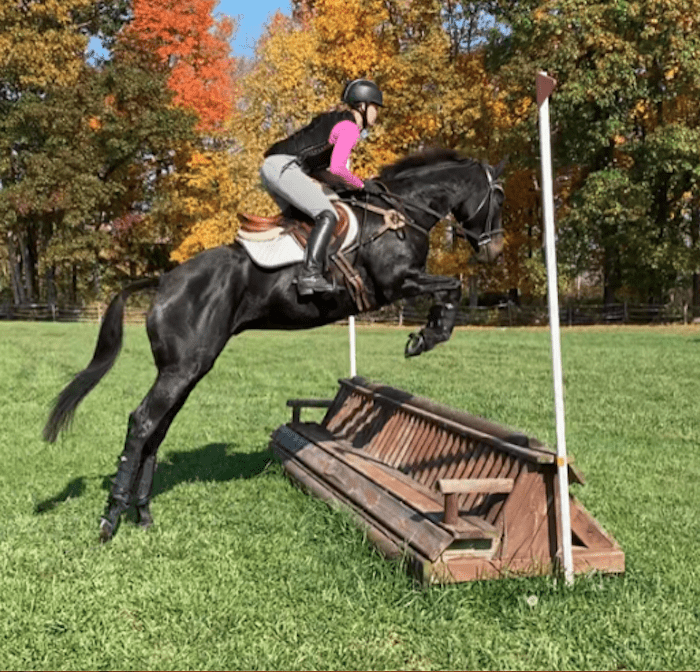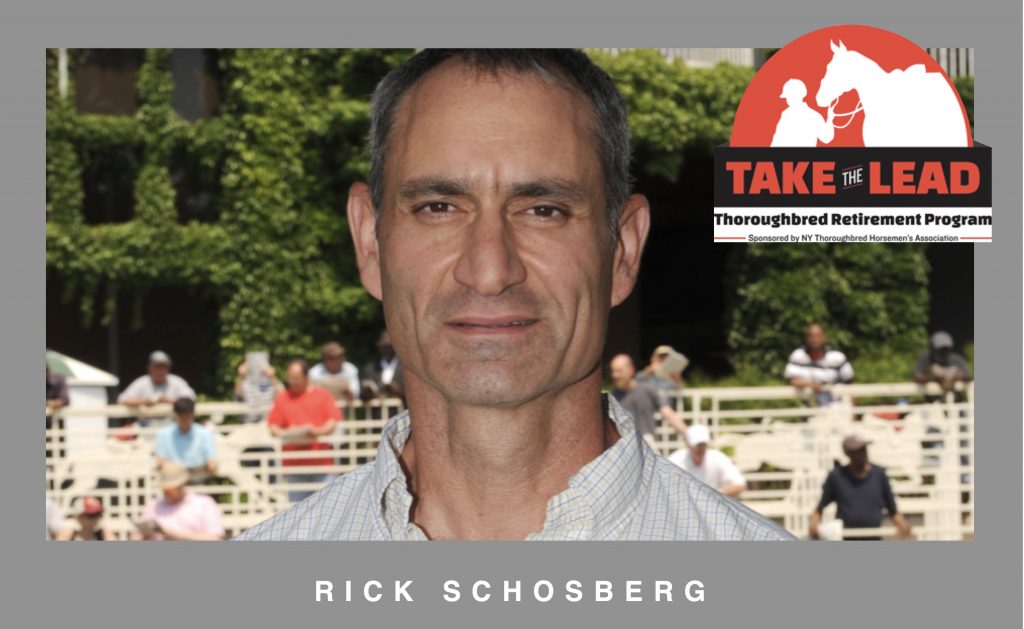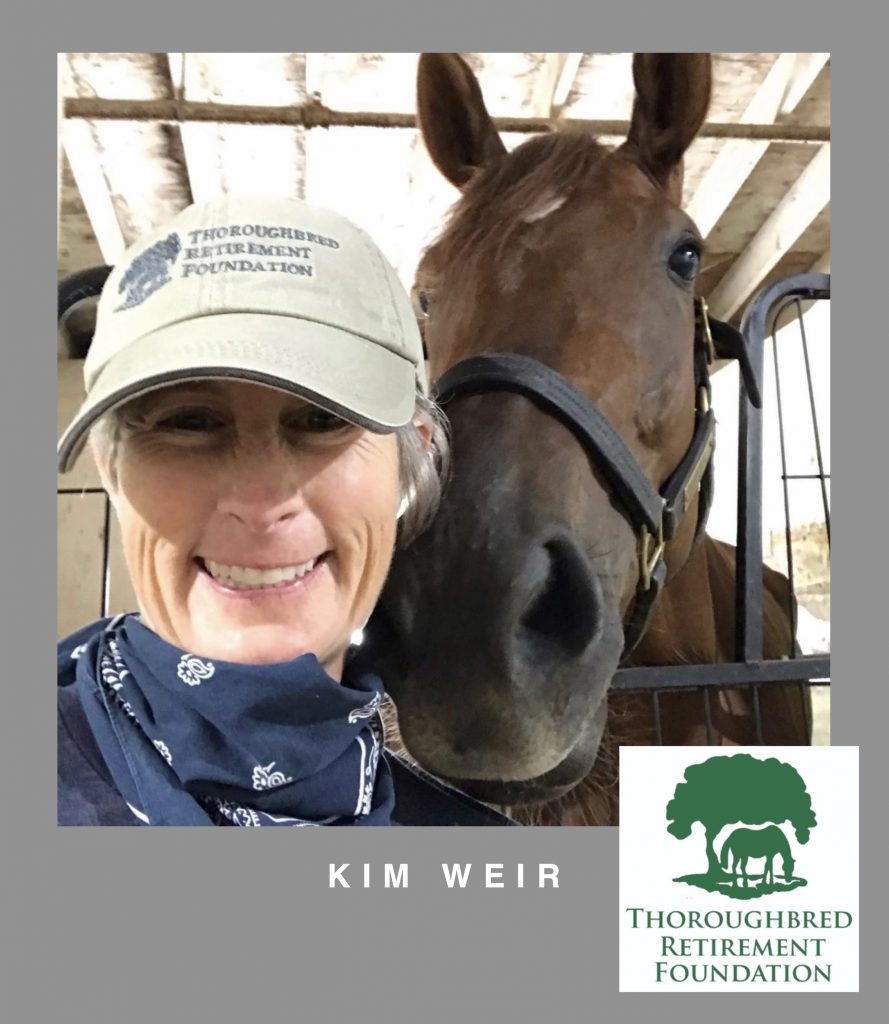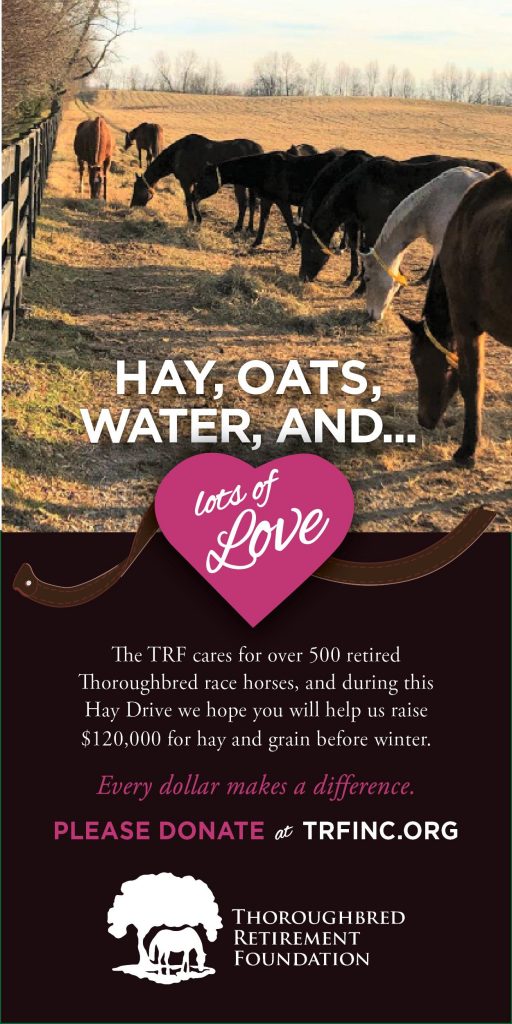
OZONE PARK, N.Y. – For Stacie Clark Rogers of the Thoroughbred Aftercare Alliance (TAA), there are several ways to measure progress in aftercare.
One is concrete: following up the TAA’s banner 2021 by continuing to pursue the organization’s proven, long-range strategy in 2022 of raising funds for TAA-accredited aftercare facilities – all geared to re-homing retired racehorses.
The other is more personal, best measured by the tales of the racehorses adopted and how they’re thriving in their new careers. For Clark Rogers, the industry’s “success stories” are what she and the others in the aftercare community relish most of all.
“Fundraising will continue to be our primary focus because the assistance goes directly to the organizations now caring for the horses,” said Clark Rogers, the TAA’s operations consultant. “But we love hearing the follow-up stories about the horses adopted and how they’re doing. In New York, that means building on a number of successes in what was a great 2021.”
The TAA awarded a record $3.7 million in grants in 2021 to 82 of its accredited aftercare organizations comprising approximately 180 facilities in North America, including 10 in New York State.
Clark estimates that since the TAA’s inception it has affected approximately 13,700 horses, a number that should grow by more than 3,500 in 2022, which is about the average of the last several years.
Among the organization’s highlights in 2021 was the inaugural TAA Day in August at Saratoga Race Course, which generated nationwide attention to the importance and benefits of thoroughbred aftercare. The two-day event on Whitney Weekend raised funds for various TAA-affiliated organizations and provided significant exposure to aftercare at one of the country’s most prestigious and closely followed meets.

“NYRA and the New York horsemen have been great supporters of TAA since our inception (in 2012), but TAA Day at Saratoga was amazing,” said Clark Rogers. “For us, it was a validation that aftercare is an integral part of our industry – and one that embraces the whole diverse racing community. That it happened at Saratoga, with such a large fan base and all the media coverage, was huge.”
Backing the TAA in its pursuit of industry-wide funding is the steadfast year-round support of NYRA and its horsemen. Every owner competing at NYRA racetracks donates $10 per start to the TAA, which funds the aftercare organizations that provide homes for retired racehorses.
New York’s horsemen also donate 1.5 percent of the purchase price of every horse claimed at a NYRA track to TAA and the New York Thoroughbred Horsemen’s Association’s Take the Lead program, which provides preliminary vet exams and treatment, as well as costs related to transportation, rehabilitation or retraining. The recently concluded Big A fall meet saw 47 total claims made for a total of more than $1.34M, generating in excess of $20,000 for aftercare.
Meanwhile, the hard work of accrediting more facilities and re-homing retired racehorses continues. Among the organizations achieving TAA accreditation in 2021 was Therapeutic Horses of Saratoga or THS, which specializes in equine assisted therapy and rescues and retrains retired racehorses for hands-on work with individuals in need. Clark Rogers is soon headed to Spokane, WA, where she plans to meet with officials of a prison about setting up an aftercare program that uses horses to help rehabilitate inmates.
Small wonder that rehoming retired racehorses is an everyday task involving a never-ending number of details for New York-based trainer Rick Schosberg, who is on the TAA board and also runs the Take The Lead retirement program.

Schosberg said the Take The Lead program is “rapidly approaching” its 900th horse placed thorough the program, a number it should hit in 2022.
“At the moment, I have 12 horses who are transitioning off the track,” Schosberg said. “At any time of the week, we have anywhere from five to 12 horses on our list in different phases of transition. We are very busy and have horses leaving for retirement all the time.”
Take The Lead’s goal with each horse is to create a profile and then network with potential aftercare facilities. To do so, the organization gathers information and medical records and ensures that a vet provide a thorough evaluation of each horse for soundness or any lingering injuries. Key is the need to research and find those horses the best fit and career, whether it’s show jumping, dressage, part of a rehabilitation program or as a companion, turned out on the family farm.
Working to a retired racehorse’s advantage is what Schosberg called “an innate ability to learn new things.”
“[From knowing] the starting gate, the big track, the little track and jogging the right way and the wrong way, they’re already processed for that,” Schosberg said.
To make it work, Schosberg, Take The Lead’s executive director, Andy Belfiore, and aftercare coordinator, Kristin Mason, hold weekly conference calls with an eye to where the horses in transition stand. No detail is too small, from evaluating a thoroughbred’s quirks and habits to bringing in a vet for an exam to checking on van schedules to see if there are any slots on an upcoming trip to Saratoga or Florida in which a transitioning horse might catch a ride to its new home.
“All in all, it’s a busy week and there are times when we’re inundated [with aftercare work],” said Schosberg. “The funny thing is that with modern technology, there are a lack of parameters, and I’ll get a call about a horse at 7 p.m. or 4 a.m. I tend to do a lot of my aftercare work before training – that’s between 3:30 a.m. to 5 a.m. when I’m headed to the barn. A lot of the answers to my questions come back in ‘now time,’ so I have them by the time training is finished. Things can move along pretty quickly.”
Schosberg added that the commitment to aftercare from owners, NYTHA, NYRA and other parts of the industry in New York, combined with the best racing in the country, make New York “better than any other jurisdiction” when it comes to aftercare.
“Because New York has the best racing, it should have the best aftercare facilities – and it does.” he said. “It’s why they [aftercare organizations] want to be here and there are several great ones from ReRun Thoroughbred Aftercare to Akindale Thoroughbred Rescue and others.”
There are success stories just about everywhere you look. In 2021, ReRun Thoroughbred Aftercare in East Greenbush, N.Y. arranged the adoption of between 90 and 110 retired thoroughbreds, all but about 10 of which are former NYRA horses, according to its executive director Lisa Molloy.
“We work primarily with NYRA because hands down, they’re the best racehorses,” said Molloy. “That makes us about as ‘New York’ as it gets.”
Among the recent adoptees at ReRun was the New York-bred Ragnar Lothbrok. Trained by Gary Gullo, the dark bay ran at all three NYRA tracks, but was retired after five races due to injury. Adopted in January 2020 by the Fuller family of Poultney, Vermont, the dark bay now competes in eventing and dressage with Tayah Fuller, a 15-year-old freshman at Poultney High School.
In October, Ragnar Lothbrok who the family now calls Zyn, and Fuller came in third for show jumping and eventing at the Retired Racehorse Project in Lexington, Kentucky.
The Fullers also have two other horses on their farm. In November, the family adopted another NYRA veteran, the Kentucky-bred Recidivist who was trained by Kelly Breen. It’s Tayah’s responsibility to care for all of them.
“We couldn’t possibly have received a better match than Zyn,” said Rommy Fuller-Young, Tayah’s mother. “He’s athletic, intelligent and has the best temperament. He’s really the perfect fit.”

Five furlongs with…Kim Weir
This month’s edition of five furlongs visits with Kim Weir, the Thoroughbred Retirement Foundation‘s Director of Major Gifts & Planned Giving.
A resident of Saratoga Springs, N.Y., Weir oversees fundraising for the TAA-accredited Thoroughbred Retirement Foundation and its unique Second Chances Program, which uses former racehorses to teach equine care as a vocation for inmates at correctional facilities across the United States.
NYRA enjoys a special connection with the TRF via their longtime herd leader Quick Call, the late two-time Forego winner, who transitioned in his post-racing career to a starring role at the TRF, working with inmates at Wallkill Correctional Facility in upstate New York. The Grade 3 Quick Call Stakes is traditionally run on Opening Day each summer at Saratoga. In July, the ashes of Quick Call were laid to rest at Clare Court on the Saratoga backstretch.
What is the mandate of the TRF?
The mission of the TRF is to save Thoroughbred racehorses no longer able to compete on the racetrack from possible neglect, abuse and slaughter.
Within the broader mosaic of the Thoroughbred Aftercare community, the TRF plays a very specific role. We provide sanctuary to those horses who can no longer pursue an athletic career. In fact, beyond our accreditation by the Thoroughbred Aftercare Alliance, we are accredited by the Global Federation of Animal Sanctuaries. The TRF is, in effect, a safety net for those racehorses who are the most at risk when their utility as athletes has ceased. We love them and make the most of their gifts as teachers through our TRF Second Chances Program as well as at our TRF Sanctuary Farm at Chestnut Hall.
In some cases, horses will come to us immediately after their racing career has ended if an injury leaves them unsuited for retraining and rehoming. In other cases, horses will come to us much later in their lives, when they have aged out of their second or third career. We make a promise of a lifetime to each retired Thoroughbred that joins the TRF Herd, ensuring that each horse in our herd will be safe and cared for for the remainder its days.
What makes a horse a good fit for the TRF herd?
There are three criteria applied to each horse that seeks a spot within the TRF Herd, either through Responsible Retirement (owner supported) or Request for Rescue (surrender). These criteria are:
- The horse must be a Jockey Club registered Thoroughbred
- The horse must have raced, at least one time.
- The horse must be pasture sound to live in one of our 19 Sanctuary or Second Chances Farms across the country. Horses that are sound and suitable for riding will be referred to other TAA accredited organizations that specialize in retraining and rehoming.
In some cases, horses will come to us immediately after their racing career has ended – if an injury has left them unsuitable for retraining and rehoming. In other cases, horses will come to us much later in their lives, when they have aged out of their second or third career. We have horses in our herd who have been school horses, fox hunters, police horses, polo ponies, broodmares, and more. Once they come to us, they will be permanently retired from being ridden and live out their days simply “being horses” in pastures across the country (including eight TRF Second Chances Programs in correctional facilities across the US).
Who is your “heart horse” in the TRF herd and why?
Each horse has a story and, as corny as it sounds, I love them all. At each farm I visit, I find a new heart horse and they usually have a similar story – they either raced a little or they raced a lot, but they never really found their way to the winners circle. They did their job, they did their best, but they just got by. Some call them the “blue collar” horses, but as a former school teacher, I think they are just the “average students” who simply didn’t excel at school [in the classroom/ at the racetrack]. Their strengths may have been elsewhere, but they still deserve our care for doing what they were created, trained and asked to do, as well as they could.
This past year with the opening of our new TRF Sanctuary Farm at Chestnut Hall, just outside of Louisville, I found myself frequently telling the story of a very special little flea bitten grey mare who lives there. Her name is Raisin’ Silver, she is a New York-bred, she had 24 starts, 2 first, 2 seconds and 2 thirds [total earnings $44,595]. Her sweet and docile disposition routinely puts her at the bottom of the pecking order in her pasture, but she was the brave and plucky little hero who decided to lead the parade of TRF horses as they moved to the new farm last March. On that blustery Spring morning, she was both sweet and brave, and has found her calling as a Herd Ambassador at Chestnut Hall.
What were some of the highlights of 2021 for the TRF?
Oh my! 2021 was truly an extraordinary year for the horses of the TRF. After all the challenges faced by so many in 2020, we found that the community that cares for our horses was more passionate, dedicated and creative than ever in their desire to demonstrate their love. The TRF Team is profoundly grateful for the many individuals who took our work to heart and sought out new and creative ways to raise money for our herd and to share the story of our work, far and wide. We simply cannot convey adequate thanks for these inspiring individuals who assumed the mantel of Ambassador for the “herd we serve”, who helped us raise precious resources for our beloved herd, and whose actions demonstrated powerful examples of leadership which may inspire others.
Examples included two Gumbo for the Horses events in Saratoga this summer – one featuring the culinary handiwork of beloved New York Jockey, Kendrick Carmouche, and the other featuring National Handicapping Champion, Michael Beychok.
We also celebrated two very special milestones for our TRF Second Chances Program. We opened our first TRF Second Chances Juvenile Program in partnership with the Florida Department of Juvenile Justice and we celebrated the 20th Anniversary of our TRF Second Chances Program at Lowell Correctional Institution [our only women’s prison program].
What are the some of the goals for the TRF in 2022?
Above all, our goal for every year is the same. To care for each and every one of the horses in our beloved herd and to ensure their safety, welfare and comfort. This work happens every day, regardless of the circumstances, because the horses are counting on us.
In 2022, we are hopeful that we will have one or two new TRF Second Chances Programs to announce and we will begin to build “the buzz” about our 40th anniversary of the TRF Second Chances Program at Wallkill Correctional Facility – our first program, which was started in 1983, in New York. Stay tuned!

NYRA Press Release
Top photo: Bred in Maryland and campaigned on the east coast, Crazed retired from racing sound and ready for a second career. He is one of TAA’s success stories. Read about Crazed here. (Photo courtesy of TAA)
Photo of Stacie Clark Rogers courtesy of OwnerView.
Photo of Rick Schosberg courtesy of NYRA/Coglianese
Photo of Kim Wier courtesy of NYRA



